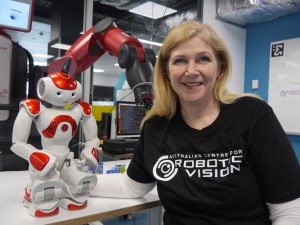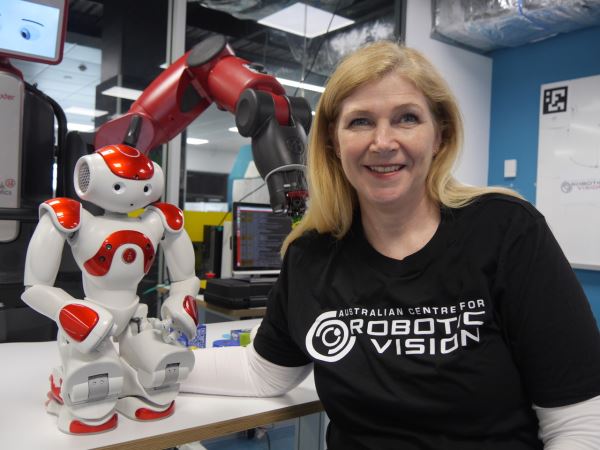Robots are changing our lives.
They’ve been around for more than five decades helping people to do things that are typically tedious, repetitive, dirty and/or downright dangerous.
The robotics industry has progressed in leaps and bounds over that period – from basic mechanical assist systems to the development of driverless cars, drones and collaborative assistants.
Through the use of robots we’re seeing a new industrial revolution. We now have machines that can physically interact with the world and assist with basic daily tasks, work, and leisure activities.
We have seen tremendous progress on robot technology across manufacturing and healthcare applications. We have also seen significant development in core technologies such as camera systems, communication systems, displays and basic computing.
With the advent of this amazing technology we are now entering perhaps the most exciting era in world history. Robots will drive global economic growth and improve quality of life for millions of people.
Male-orientated domain
Yet few women – especially in Australia – are pursuing a career in robotics. Robotics has become a male-orientated domain across the globe.
Dr Sue Keay is one of handful of key people in Australia looking to change that gender imbalance.
In her role as Chief Operating Officer for the Australian Centre for Robotic Vision she is in a position of influence – and is an ideal “robotics role model” for female students.
Earlier this year Science & Technology Australia (STA) named Dr Keay as one of its inaugural “Superstars of STEM”.
Dr Keay was one of only 30 women from around Australia selected from more than 300 applicants in the first year of the program.
Science & Technology Australia says the goal of the program is to help women learn how to speak about their science and inspire others to consider careers in science, technology, engineering and mathematics (STEM).
Centre of excellence
“This program is vital to ensure that women participate and remain engaged in STEM,” says Dr Keay.
Dr Keay has been the COO for the Australian Centre for Robotic Vision since it was created in 2014. As an Australian Research Council (ARC) Centre of Excellence, the Centre brings together the disciplines of robotics and computer vision. Researchers are working to create robots that see and understand their environment.
“There are very few women in technology. There are even fewer in robotics and computer vision. Yet, the opportunities to change the world in these fields is incredible,” says Dr Keay.
“I am highly motivated to raise the profile of technology, especially amongst women, to ensure that Australia is prepared for the significant changes that will soon engulf us. From robotic process automation to autonomous vehicles, things that were once in the realm of science fiction will soon become a reality.”
More gender diversity is needed
Recently, she developed a successful $1.5-million R&D project on humanoid robotics supported by the Queensland government to explore the vision capabilities of Softbank’s social robot, Pepper.
Dr Keay works with a team of 100 researchers and academics – only eight of whom are female.
“Obviously, I would like to see that figure increase, she says.
“In my job I get an inside glimpse into some of the fantastic new technologies that are coming our way. But unfortunately most of this technology is being developed almost exclusively by men.
“It’s not good for any technologies to be exclusively produced by one gender.
“If there is any way we can encourage more women to enter these fields and be part of developing some amazing technology, then I’m very happy to put my hand up to help out.”
Breaking down the barriers
Females may be deterred from a career in robotics because of its male dominance, Dr Keay admits.
“Many women are discouraged from certain occupations because they feel it is a very female unfriendly environment.
“Anything we can do to break down the barriers and make the environment more female friendly is worth investing in.”
Do we need more role models like Dr Keay to spread the word?
“That’s just part of the solution,” she says. “It’s not an easy problem to solve.
“When I was at school there wasn’t too much choice – you had to do science and maths.
“Perhaps we should look at ways where everybody is exposed to science and maths given technology is have such a huge impact on our lives.
“It’s becoming an important life skill we all need to know.”
Sharing their stories
Science & Technology Australia says the Superstars of STEM program will also include a mentoring component. Participants will share their stories at local high schools to ensure they are connecting with young Australian women interested in STEM.
“We want Australian girls to realise that there are some amazing, capable and impressive women working as scientists and technologists too, and that they work in and out of the lab in places you might not expect,” says Professor Emma Johnston, Science & Technology Australia President-Elect.
As a mother of two daughters, Dr Keay says she’s always felt a responsibility to make sure there are more STEM opportunities for young women.
Spreading the word
“There were significant improvements in the workplace from my mother’s generation to my own, but I don’t see a similar amount of progress benefitting my daughters’ generation. This has to change, and I’m keen to be an active participant in changing things,” says Dr Keay.
The 30 women selected for the Superstars of STEM program will receive training and development to use social media, TV, radio and public speaking opportunities to help them talk about their science and to spread the word about the women in STEM.
The group will meet regularly to discuss strategies to engage with political leaders and key policy makers to develop new policies to help promote STEM in Australia.
The Superstars of STEM comprise eight representatives from Victoria, eight from NSW, five from SA, five from QLD, two from Tasmania and two from ACT.


